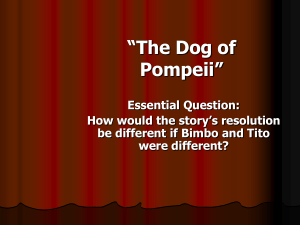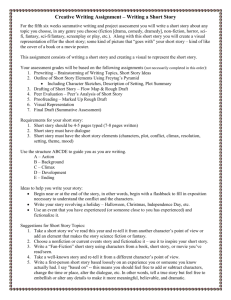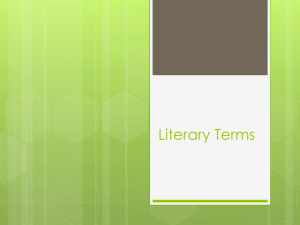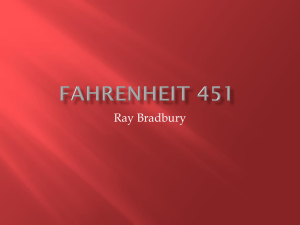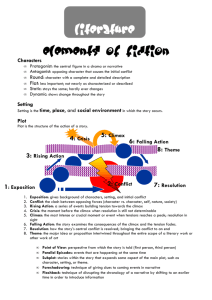THE SHORT STORY
advertisement
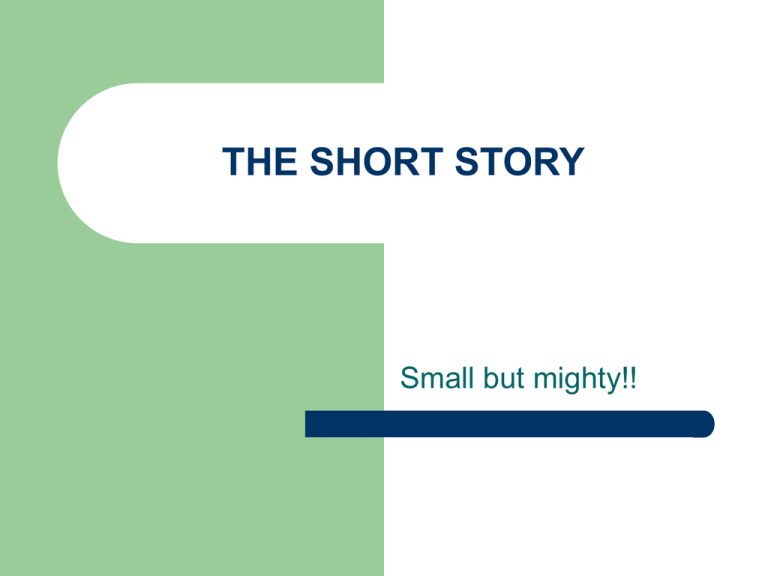
THE SHORT STORY Small but mighty!! Definition A short work of prose fiction that is shorter than a novel Prose: a style of writing that is closer to everyday speech (basically, not verse) Elements A short story is a work of fiction that is usually written in prose, often in narrative format. This format tends to be briefer than longer works of fiction, such as novellas and novels or books. Short story definitions based upon length differ somewhat even among professional writers. Since the short story format includes a wide range of genres and styles, the actual length is determined by the individual author's preference (or the story's actual needs in terms of creativity or the story arc). Guidelines vary greatly among publishers. PLOT What happens in a story, or the “storyline” Plot is often designed with a narrative structure or story arc that includes five parts. What are they? exposition, conflict, rising action and climax, followed by a falling action and resolution Plot Pyramid (RESOLUTION) Exposition Exposition is the beginning of the plot that is concerned with introducing characters and setting. These elements may be largely presented at the beginning of the story, or may occur as a sort of incidental description throughout. Rising Action Rising Action is the central part of a story during which various problems arise, leading up to the climax. Conflict is the "problem" in a story which triggers the action. Conflict Conflict is a struggle between opposing forces. External conflict a character clashes with an outside force—for example, another character, society, or nature. Internal conflict a character grapples with his or her own opposing feelings, beliefs, needs, or desires. Conflict drives the plot forward. Can you have a story without conflict? Climax The climax is the high point of the story, where a culmination of events create the peak of the conflict. The climax usually features the most conflict and struggle, and usually reveals any secrets or missing points in the story. The climax isn't always the most important scene in a story. In many stories, it is the last sentence, with no successive falling action or resolution. Falling Action The falling action is the part of a story following the climax. This part of the story shows the result of the climax, and its effects on the characters, setting, and proceeding events. Resolution Also called a dénouement (derived from French, meaning to “untie the knot”) – Pronounced day-noo-mahn A resolution or dénouement is the conclusion of the story. Conflicts are resolved, creating normality for the characters. Be aware that not all stories have a resolution. What makes a good short story? Turn to your talk partners and discuss. You have one minute. Edgar Allan Poe’s Rules for Short Stories A short story should: Be complete by itself. Be able to be read in one sitting. Have every word used for important effect. Have a good opening sentence that is developed throughout the work. End at its climax. Have no more characters than those necessary for the action. Vonnegut’s Rules 1. Use the time of a total stranger in such a way that he or she will not feel the time was wasted. 2. Give the reader at least one character he or she can root for. 3. Every character should want something, even if it is only a glass of water. 4. Every sentence must do one of two things -- reveal character or advance the action. 5. Start as close to the end as possible. 6. Be a sadist. No matter how sweet and innocent your leading characters, make awful things happen to them -- in order that the reader may see what they are made of. 7. Write to please just one person. If you open a window to the world, so to speak, your story will get pneumonia. 8. Give your readers as much information as possible as soon as possible. To heck with suspense. Readers should have such complete understanding of what is going on, where and why, that they could finish the story themselves, should cockroaches eat the last few pages. Setting Writers describe the world they know. Sights, sounds, colors, and textures are all vividly painted in words as an artist paints images on canvas. A writer imagines a story to be happening in a place that is rooted in his or her mind. The location of a story's actions, along with the time in which it occurs, is the setting. Setting is created by language. How many or how few details we learn is up to the author. Many authors leave a lot of these details up to the reader's imagination. Setting Setting tells us where and when a story takes place. Setting can include location, the weather, the time of day, and the time period (past, present, or future.) Setting can even include people’s customs-how they live, dress, eat, and behave. The purpose of setting is to provide a background— a place where the characters can live and act. NOTE: A good setting make a story memorable! How is setting created? Setting is created using imagery. What is imagery? Images are words or phrases that call forth a response from our senses—sight, smell, touch, hearing, and taste. Setting, Mood, and Tone Setting can also provide mood, or atmosphere—it can affect the way we feel. The emotional effect created by a story’s atmosphere draws us into the plot and makes us care about the characters. Writers can also use setting to help express a tone, or attitude toward a subject or character. MOOD How can setting affect mood? If a story is set in a wild forest at night, with wolves howling in the distance, what mood is created? – A mood of terror, tension, or uneasiness If a story is set in a cozy cottage with a garden full of sunlight and the chirps of birds, what mood is created? – A mood of peace, calm, comfort TONE How is tone created? Tone is conveyed through the writer’s choice of words and details. DICTION A writer’s choice of words is called diction. – Words have connotative and denotative meanings. dictionary definition Connotation meanings, associations, or emotions attached to words Denotation “Hills Like White Elephants” by Earnest Hemingway Written in 1927 during Modernism period Break with traditional forms and subject matters First war between everyone (1914-1918) – – Economic shift – – Great brutality Is this what we’ve become More mechanized, systemized Workers needed less Led to fragmentation and disillusionment Modernism cont… Ezra Pound said, “Make it new!” Broke the rules of the narrative – – – Stream of consciousness Complicated internal monologues Protagonist changed to an alienated, isolated character Americans experiencing new things – – – Most went to war Many went to Paris so they could live comfortably Very glamorous, but terrifying Modernism cont… Hemingway used the Iceberg theory – – – – Every word matters Creates room for interpretation Makes you struggle for meaning He wants you to put the pieces back together Read “Hills Like White Elephants” Written in 1927 After Reading There is obviously a disagreement about something. What do you think they are talking about? Close Read Highlight descriptions of the setting in yellow or underline with your talk partner Highlight discussion between characters in another color or circle What seems to be important? If it seems important, it probably is. Write a paragraph: Using these clues, what do you think they are talking about? Why do you think this? Cite textual evidence to support your answer.

